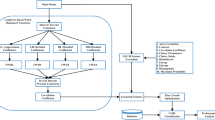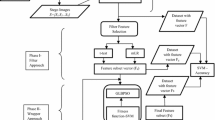Abstract
Image steganalysis is the process of detecting the availability of hidden messages in the cover images. Therefore, it may be considered as a classification problem which categorizes an image either into a cover images or a stego image. Feature selection is one of the important phases of image steganalysis which can increase its computational efficiency and performance. In this paper, a novel levy flight-based grey wolf optimization has been introduced which is used to select the prominent features for steganalysis algorithm from a set of original features. For the same, SPAM and AlexNet have been used to generate the high dimensional features. Furthermore, the random forest classifier is used to classify the images over selected features into cover images and stego images. The experimental results show that the proposed levy flight-based grey wolf optimization shows preferable convergence precision and effectively reduces the irrelevant and redundant features while maintaining the high classification accuracy as compared to other feature selection methods.









Similar content being viewed by others
References
Amirsadri S, Mousavirad SJ, Ebrahimpour-Komleh H (2017) A levy flight-based grey wolf optimizer combined with back-propagation algorithm for neural network training. Neural Comput & Applic 28:1–14
Bhattacharyya S, Sengupta A, Chakraborti T, Konar A, Tibarewala D (2014) Automatic feature selection of motor imagery eeg signals using differential evolution and learning automata. Med Biol Eng Comput 52:131–139
Chechkin AV, Metzler R, Klafter J, Gonchar VY et al. (2008) Introduction to the theory of lévy flights, Anomalous transport: Foundations and applications 129–162
Chen C, Shi YQ (2008) Jpeg image steganalysis utilizing both intrablock and interblock correlations. In: Proc of IEEE international symposium on circuits and systems, pp 3029–3032
Chhikara RR, Sharma P, Singh L (2016) A hybrid feature selection approach based on improved pso and filter approaches for image steganalysis. Int J Mach Learn Cybern 7:1195–1206
Chhikara RR, Sharma P, Singh L (2016) An improved dynamic discrete firefly algorithm for blind image steganalysis. Int J Mach Learn Cybern 6:1–15
Cotter SF, Kreutz-Delgado K, Rao BD (2001) Backward sequential elimination for sparse vector subset selection. Signal Process 81:1849–1864
Dash M, Liu H (1997) Feature selection for classification. Intelligent Data Analysis 1:131–156
Deepa S (2017) Steganalysis on images using svm with selected hybrid features of gini index feature selection algorithm. Int J Adv Res Comput Sci 8:1503–1509
Deng H, Runger G (2012) Feature selection via regularized trees. In: Proc of international joint conference on neural networks, pp 1–8
Derrac J, García S, Molina D, Herrera F (2011) A practical tutorial on the use of nonparametric statistical tests as a methodology for comparing evolutionary and swarm intelligence algorithms. Swarm Evol Comput 1:3–18
Dumitrescu S, Wu X, Wang Z (2003) Detection of lsb steganography via sample pair analysis. IEEE Trans Signal Process 51:1995–2007
Emary E, Zawbaa HM, Grosan C, Hassenian AE (2015) Feature subset selection approach by gray-wolf optimization. In: Proc of Afro-European conference for industrial advancement, pp 1–13
Emary E, Zawbaa HM, Hassanien AE (2016) Binary grey wolf optimization approaches for feature selection. Neurocomputing 172:371–381
Fridrich J, Goljan M (2004) On estimation of secret message length in lsb steganography in spatial domain. In: Security, steganography, and watermarking of multimedia contents VI, pp 23–35
Glorot X, Bordes A, Bengio Y (2011) Deep sparse rectifier neural networks. In: Proc of international conference on artificial intelligence and statistics, pp 315–323
Guettari N, Capelle-Laizé AS, Carré P (2016) Blind image steganalysis based on evidential k-nearest neighbors. In: Proc of IEEE international conference on image processing, pp 2742–2746
Guyon I, Weston J, Barnhill S, Vapnik V (2002) Gene selection for cancer classification using support vector machines. Mach Learn 46:389–422
Jamil M, Yang X-S (2013) A literature survey of benchmark functions for global optimisation problems. International Journal of Mathematical Modelling and Numerical Optimisation 4:150–194
Kodovskỳ J, Fridrich J (2009) Calibration revisited. In: Proc of ACM workshop on multimedia and security, pp 63–74
Kodovskỳ J, Fridrich J (2011) Steganalysis in high dimensions: fusing classifiers built on random subspaces. In: Media watermarking, security, and forensics III, p 78800L
Kodovsky J, Fridrich J, Holub V (2012) Ensemble classifiers for steganalysis of digital media. IEEE Trans Inf Forensics Secur 7:432–444
Kohavi R, John GH (1997) Wrappers for feature subset selection. Artif Intell 97:273–324
Krizhevsky A, Sutskever I, Hinton GE (2012) Imagenet classification with deep convolutional neural networks. In: Advances in neural information processing systems, pp 1097–1105
Liu Q (2011) Steganalysis of dct-embedding based adaptive steganography and yass. In: Proc of ACM multimedia workshop on multimedia and security, pp 77–86
Lu P, Luo X, Tang Q, Li S (2004) An improved sample pairs method for detection of lsb embedding. In: Information hiding, vol 3200. Springer, pp 116–127
Luo X-Y, Wang D-S, Wang P, Liu F-L (2008) A review on blind detection for image steganography. Signal Process 88:2138–2157
Massart DL, Smeyers-verbeke AJ et al. (2005) Visual presentation of data by means of box plots, Practical data handling. LC-GC Europe 18:215–218
Mirjalili S, Mirjalili SM, Lewis A (2014) Grey wolf optimizer. Adv Eng Softw 69:46–61
Mohammadi FG, Abadeh MS (2014) Image steganalysis using a bee colony based feature selection algorithm. Eng Appl Artif Intell 31:35–43
Muangkote N, Sunat K, Chiewchanwattana S (2014) An improved grey wolf optimizer for training q-gaussian radial basis functional-link nets. In: Proc of international conference on computer science and engineering, pp 209–214
Nissar A, Mir A (2010) Classification of steganalysis techniques: a study. Digital Signal Process 20:1758–1770
Pevny T, Bas P, Fridrich J (2010) Steganalysis by subtractive pixel adjacency matrix. IEEE Trans Inf Forensics Secur 5:215–224
Pevnỳ T, Fridrich J (2005) Towards multi-class blind steganalyzer for jpeg images. In: Proc of international workshop on digital watermarking, pp 39–53
Pevny T, Fridrich J (2007) Merging markov and dct features for multi-class jpeg steganalysis. In: Proc of electronic imaging, pp 650503–650503
Qin C, Chang C-C, Hsu T-J (2015) Reversible data hiding scheme based on exploiting modification direction with two steganographic images. Multimedia Tools and Applications 74:5861–5872
Qin C, Chang CC, Huang YH, Liao LT (2013) An inpainting-assisted reversible steganographic scheme using a histogram shifting mechanism. IEEE Trans Circuits Syst Video Technol 23:1109–1118
Ramezani M, Ghaemmaghami S (2010) Towards genetic feature selection in image steganalysis. In: Proc of IEEE consumer communications and networking conference, pp 1–4
Rashedi E, Nezamabadi-Pour H, Saryazdi S (2009) Gsa: a gravitational search algorithm. Inform Sci 179:2232–2248
Saraswat M, Arya K (2014) Feature selection and classification of leukocytes using random forest. Med Biol Eng Comput 52:1041–1052
Saraswat M, Arya K, Sharma H (2013) Leukocyte segmentation in tissue images using differential evolution algorithm. Swarm Evol Comput 11:46–54
Sheikhan M, Pezhmanpour M, Moin MS (2012) Improved contourlet-based steganalysis using binary particle swarm optimization and radial basis neural networks. Neural Comput & Applic 21:1717–1728
Simon D (2013) Evolutionary optimization algorithms. Wiley, Hoboken
Yang X-S (2014) Nature-inspired optimization algorithms. Elsevier, New York
Yao X, Liu Y, Lin G (1999) Evolutionary programming made faster. IEEE Trans Evol Comput 3:82–102
Zhang T, Ping X (2003) A new approach to reliable detection of lsb steganography in natural images. Signal Process 83:2085–2093
Author information
Authors and Affiliations
Corresponding author
Additional information
Publisher’s Note
Springer Nature remains neutral with regard to jurisdictional claims in published maps and institutional affiliations.
Rights and permissions
About this article
Cite this article
Pathak, Y., Arya, K.V. & Tiwari, S. Feature selection for image steganalysis using levy flight-based grey wolf optimization. Multimed Tools Appl 78, 1473–1494 (2019). https://doi.org/10.1007/s11042-018-6155-6
Received:
Revised:
Accepted:
Published:
Issue Date:
DOI: https://doi.org/10.1007/s11042-018-6155-6




